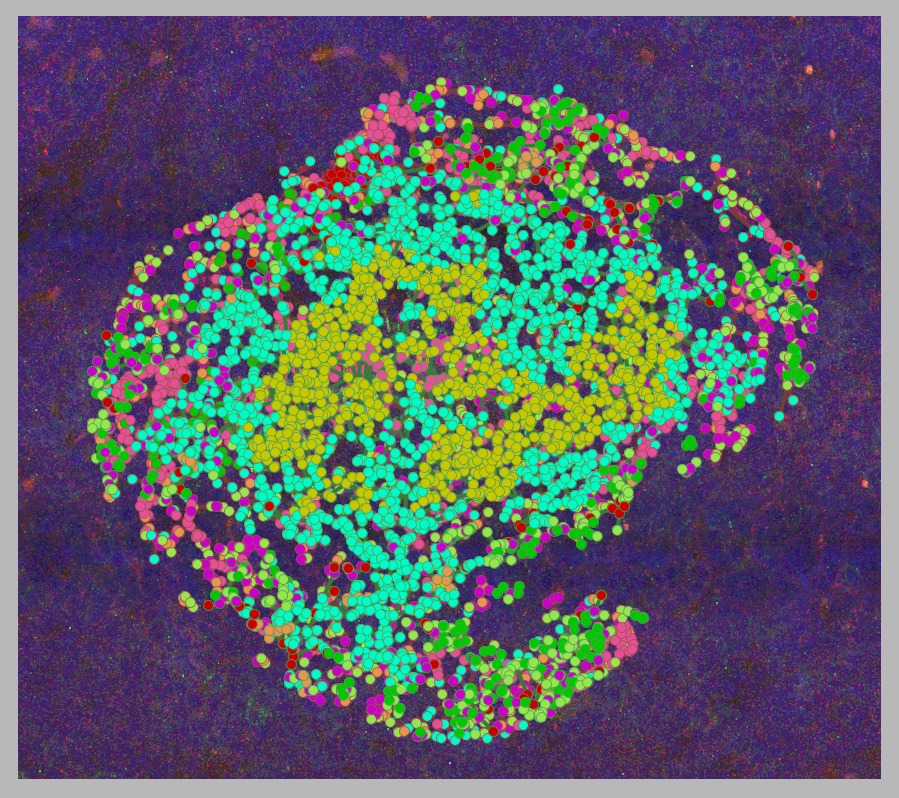August 9, 2023
Understanding the network of the specific immune response
Steinberg Foundation promotes Hendrik Schäfer
The Rudolf Steinberg Foundation supported the bioinformatician Dr Hendrik Schäfer at FIAS. Now Schäfer presented his findings on follicular dendritic cells, which form network-like structure in the lymph nodes and could possibly improve the diagnosis of lymph node tumours. The Steinberg Fund supported the career start of this outstanding young scientist for six months.
The human immune system as a complex, decentralised defence system effectively protects us from various pathogens. In the process, the specific immune response allows targeted combat. And with the differentiation into memory cells, the body receives an immunological memory as protection against future infections.
During an immune response, germinal centres develop in organs such as lymph nodes and spleen. Follicles there produce antibodies. Schäfer's research focuses on follicular dendritic cells (FDCs), a network-like structure that significantly determines the shape and structure of these germinal centres. FDCs are involved in most processes of the germinal centre reaction. They control signalling proteins, present antigens on their surface and serve as an orientation guide for cells moving along the network structure. Despite this important role, FDCs have not yet been the focus of attention in the treatment and diagnosis of patients. The research group led by FIAS Senior Fellow Martin-Leo Hansmann, in which Schäfer works, suspect that the structure of the FDC network and the morphology of the cells provide detailed information about the state of the germinal centre and its immune efficiency. This information could help to assess and treat altered lymph nodes.
Schäfer developed methods to evaluate 3D tissue sections of human lymph nodes. He determined the distribution of certain surface features of cells in the germinal centre and examined the network properties of the FDCs. Various properties such as number of branches, amount of FDC and others are graphically processed. Based on the properties, the data were clustered to characterise subregions in the germinal centre. In the figure, the calculated clusters are shown in different colours: Regions of the same colour in the germinal centre show a high structural similarity, while differently coloured regions differ in their properties.

Figure: Calculated subregions in the germinal centre of the lymph nodes: Regions of the same colour in the germinal centre show high structural similarity. © Hendrik Schäfer
The different structure in the FDC network probably reflects the function and task of the respective region. Continuing the project, Schäfer is evaluating 3D and 4D images that show the FDC network in correlation to other cell types, such as T-/B-cells and macrophages. Microscopic 3D images make it possible to quantify these and observe cell contacts. 4D extends these possibilities to include cell movement, which plays an important role in signal transduction. The interplay of immune cells and the function and organisation of FDCs allows for effective immune responses in the germinal centre. In lymphoma patients, for example, the tissue in the lymph node is deregulated by malignant cells and compartment and tissue structures are partially or completely destroyed. The comparison of malignant to merely inflamed lymph nodes should make it possible to evaluate the residual ability of the germinal centre reaction and thus support pathologists in the diagnosis of lymphomas. "Our goal is to fully understand the system based on human data," Schäfer explains. This knowledge could one day be incorporated into the treatment of lymphomas.
Dr Hendrik Schäfer (38) studied and obtained his doctorate in bioinformatics at the Goethe University in Frankfurt. He worked as a research assistant at the Frankfurt University Hospital and at the Charité in Berlin. Since the beginning of this year, he has been researching at FIAS in the working group of Senior Fellow Martin-Leo Hansmann, funded by the Rudolf Steinberg Foundation Fund.
